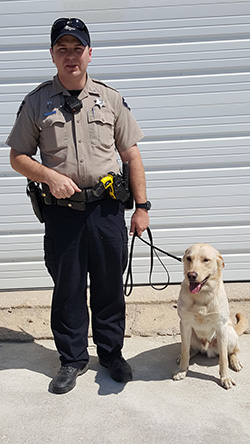Current K-9 units and Handlers:

Sergeant Justin Young and K-9 Turbo
History of Police Canines around the World
Dogs have been used by law enforcement agencies for over 100 years. The English used bloodhounds while searching for Jack the Ripper in 1888, and during that time they allowed canines to accompany bobbies (police) on patrol. In 1899, in Ghent, Belgium, police started formally training dogs for police work. This enhanced the popularity of using dogs for police work. By 1910, Germany had police dogs in over 600 of their largest cities. In 1938, South London introduced two (2) specially trained Labrador Retrievers to the Metropolitan Police Force to accompany bobbies on patrol.
In the 1970’s the use of dogs in law enforcement took a foothold in the United States. Now they are considered a part of the police force, and in many departments they even have their own badges. From the hundreds of dog breeds, there are some that are widely known for their presence in law enforcement. The most widely trained dog for regular patrol work is the German Shepherd. Other exemplary breeds include–but are not limited to–the Labrador Retriever, Belgian Malinois, and the Dutch Shepherd. Certain breeds have been used for special purposes, such as detecting illegal drugs or explosives, and tracking fugitives or missing persons.
Source: (http://www.dogsforlawenforcement.org/police-canines-in-history.html)
The K-9 Teams are utilized to aid and assist all divisions of the Pottawatomie County Sheriff’s Office. The Sheriff’s Office utilizes trained and certified K-9 teams in an effort to detect and deter the introduction and use of illegal drugs within the jurisdiction and to locate certain individuals. The K-9 Teams are assigned to, and supervised by the Patrol Division and are generally available on a 24-hour, on-call basis.
The K9 Handler:
- Accompanied by a police dog, provides police services to the community.
- Ability to physically and vocally control a police dog’s actions.
- Trains and maintains to standards, provides care for and uses specially trained dogs for law enforcement duties.
- Maintain records of canines training and performance during call-outs.
